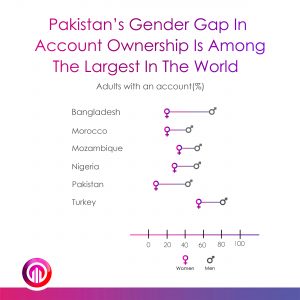
Over a billion women in the world are unbanked making the World Bank’s 2020 pledge for Universal Financial Access all but unachievable. The Financial Inclusion Gender gap in Pakistan is at least 27%, making it one of the worst in the world. Just 7% of women in Pakistan are financially included – one of the worst rates in the world.

Women are better at managing money
The negative effects of women not having financial access are not limited to the obvious disenfranchisement of one gender. They are multidimensional in nature. Women are better savers than men. As critically 90% of women’s income is invested back into their own families, compared to only 35% of men’s income. They are far more committed to getting their children educated leading to transformational effects in countries with high illiteracy rates.
The 6 keys to winning the Financial Inclusion War for women
- Solution building approach needs to change: Financial Inclusion is at a stasis. What is needed are clever personalized solutions. The current approach is solution centric while it needs to be user centric. The primary approach is technology or driven by donor needs and restricted to closed innovation reliant mostly on the experience of stakeholders involved. In such an approach, most learning happens after program or project launch. This needs to change to a user centric approach which is based on intention analysis and driven by user needs. In such an approach, you pivot the project before launch based on quick feedback loops from users driven by experts in design thinking. At the heart of this are ethnographic-feedback-based projects powered by open ended questions and excellent primary research. The key to Financial Inclusion is not banking and technology, it’s fieldwork.
In Nigeria, research showed women are good at saving and want to save. However, they stay away from banks because of fees, slow service, and daily income lost if they go avail retail banking services. Understanding this Diamond Bank launched BETA, a no-nonsense, simple, affordable account that offers doorstep service through a mobile agent network called BETA Friends. Using mobile phones accounts are opened and serviced in markets near where women work. There are nearly half a million BETA accounts currently making this program a massive success.
- Sex disaggregated data: Women in emerging markets are a very special case. Joining the economy as earners while traditionally relegated to homemaker roles is a fundamental shift. The triggers for this shift, how women can be reached in such scenarios and digitally onboarded, what drives active usage of financial services are all singular discussions. The crucial building block to understanding women is to collect sex-disaggregated data. Without data about women you cannot design products for women. Regulators often tasked with monitoring inclusion performance cannot tweak policy without this data. Gathering sex-disaggregated data in Chile revealed women were being charged 15% extra interest allowing policy decisions to be taken to mitigate that. The onus is on the regulator to use banks to collect this data and work with the right development initiatives it has influence over to do same. The United Nations Foundation’s Data2x initiatives sets clear guidelines on how to make this happen.
- Increase teledensity: The relationship between telecom services and financial inclusion is symbiotic and critical. Mobile onboarding is the cheapest most effective way of financial inclusion. The more women that have mobile phones, the more their financial inclusion will go up. Telecom gender gap in Pakistan is amongst the highest in the world with women lagging behind men by as much as 37%. The government and PTA and telecom companies need to work together to close this gap using a combination of policy and investment.
- High costs: Reducing the cost of financial onboarding and transactions has a direct relationship to women using financial services. High costs are one of the consistently cited reasons for women not using financial services. A digital ID that can be used for verification and eKYC is a key step in this direction. Mobile based financial inclusion that does not necessitate a branch visit is a key step that needs to be taken. There should be no account opening and basic services activation (entry) fees. Again regulators and government need to work here with the private sector and come up with clever solutions. A packaged deal with broadband mobile phone and regular content that informs women of best practices and gives livelihood advice subsidized fully by the government is one way. Funds from USF and another fund created by the government that takes 1% of all banking revenues to support this is the sort of bold move that is needed.
- Use disruptive technology to motivate banks: Cost of onboarding and maintaining a customer via retail for 3 years can be PKR 10,000 PKR++. This is why banks simply will not be willing partners in financial inclusion. If you onboard customers digitally efficiently using mobile phones that cost drops dramatically to PKR 950 rupees and lower. While this creates less friction, banks will still hesitate going towards financial inclusion, because they work on conventional collateral based loans model. This means women entrepreneurs from right above the poverty line are not in their sights. They key here is AI powered credit scoring. This uses phone usage to come up with credit scoring allowing banks to lend. This is not a pipe dream. Successful examples exist all over the world including startups in Pakistan whose loan success rate is in the high nineties. Biometrics for eKYC, mobile digital onboarding and AI and other disruptive technologies are key to powering women financial inclusion by making it cheaper and easy for banks to service them. Once customers are acquired microsavings workflows that should allow them to start investments with as little as 5 rupees should be initiated. That trickle will collectively become a flow of profit for banks.
- Safe passage for cash & women: A key part of enabling women to be financially included is giving them a safe place to save. Having a safe place to put assets and top up cash even in digital mobile account and getting to the place to make that transaction quickly and safely, however, remain key workflows to enable for financial inclusion. This formalizes the cash flow cycle and has important ramifications of surviving poverty inducing events and gender-based violence initiated because of cash in house. Having a mobile agent network close to where women generate economic activity is one solution. Having payments made digitally directly into a mobile account is of course one way. But clever solutions like mobile bank branches that visit markets in predefined routes can also help.
Conclusion
The fight for women’s financial inclusion must be won and we are losing it in Pakistan. Pakistan’s gender gap for financial inclusion and related metrics like teledensity gender gap are amongst the worst in the world. The net inclusion stats as % of population are also the lowest in the world. The fightback starts with treating this as a fieldwork problem and becoming user centric and identifying and prioritizing projects accordingly. You also personalize best practice projects that work elsewhere in the world using same approach. It is key to replace a “dent the ecosystem” approach where you expect one project to change major financial inclusion stats and instead rely on a guerilla approach where lots of projects identified via fieldwork add value and affect the financial inclusion stats based on segmentation and singular needs of certain groups. All of this needs to be topped up by a resilient and clever coalition of private sector, government, regulators, telecom and banks.